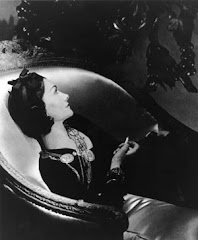The largest number of comments ever received on this site is the discussion on scarves. It seems like everyone is thinking about them.
Now the Telegraph has two pieces about the economy of having things made bespoke, an even greater rejection of the throwaway culture of cheap clothes. It argues that buying bespoke is the way to go during an economic downturn, the sartorial equivalent of 'only the rich can afford cheap shoes.'
"It may seem contradictory that people want a more specialised service when talk is of less disposable income," says Lauretta Roberts, editor of the fashion industry magazine Drapers. "But it does seem to go that way: we trade up in a downturn.
"Buying bespoke is about finding your own style and investing in it, rather than falling prey to every trend. It becomes about spending wisely and not wasting money."
During the good times of the past decade, the idea of having something custom-made was eschewed in favour of fast, throwaway fashion. But now frivolous spending on cheap clothes feels wrong - not to mention ecologically unsound - and our appetite for unique, well-made replacements is growing.
"There is a huge backlash against mass production and anything that suffers sameness," says Marian Salzman, a New York-based trendspotter. "Thus one-of-a-kind has great status. Bespoke makes us feel like we're enjoying a good life. It's the new special."

This woman had this dress designed and made for her. Personally I think it's bloody awful but if she likes it, and feels good in it, and it fits, that's the main thing.

8 comments:
Wow that's bad, but it does fit her. I see this alot on sewing blogs and forums when sewers use consumer software that enables them to design their own clothes and draft patterns.
The "enabling" aspect of software has a downside; just because someone can draft a pattern doesn’t make them a designer anymore than than being able to word process makes them a good writer!
I'm not a fan of the dress, but if she likes it...
It's nice to know that sewing, something I do anyway, is now coming back into fashion.
I'm also short and curvy, and appreciate the proper fit of that dress - but what is with the gobs of decorations, and the garish colour?
That dress would be striking if plain, and in a somewhat deeper tone.
As for bespoke, I hope they mean truly bespoke - that is properly fitted, and not just a greater choice of fabric and finishings.
That dress is like a bad Dynasty flashback, but didn't she mention she was a romance novelist?
Shades of Barbara Cartland! I googled the latter - the Wikipedia article on the grande Dame in pink also includes a very elegant photo of her as a young woman: http://en.wikipedia.org/wiki/Image:Barbara_1925.jpg
And who exactly do we think are going to be able to afford bespoke clothing? The young women buying out Primark in a frenzy every Saturday?
Sorry, this is a nice thought but will never happen en masse, purely because it is just too expensive for most women living on modest means.
In order for this sort of thing to take hold, a real cultural shift has to take place: women have to completely change their thinking about fashion and impulse purchases. Even for the person who can already sew and who has a TNT(tried and true, meaning the sewist has made it several times already, has worked out the bugs, and has made all the alterations to the patterns necessary for each iteration to fit)pattern and stash fabric at hand, it does take time to cut out the fabric and do all the steps necessary to make a nice garment. So, this will not be an impulse purchase there. For anyone who needs to go to a dressmaker, as described in the article, this process takes multiple visits, hours of standing while the dressmaker makes adjustments, etc. Men, women and children were used to this process 100 years ago, but few go through it today except for brides needing alterations on their gowns. At the same time, 100 years ago, people were also accustomed to paying 'true worth' for these items: a man's shirt, I believe I read someplace, cost a week's salary for a working man. So, people were used to having many fewer pieces of clothing in their daily lives, with many people having one outfit for every day and one outfit only for the Sabbath. When the weekday outfit could no longer be patched or turned(there's a skill no one has anymore, I think), it would be cut down and made over for a child and the adult got a new outfit for the Sabbath and the Sunday suit or dress became the everyday outfit. People today are used to having many more daily outfits than that. Of course, from a quality perpective, one really well made outfit, made of good well-wearing fabric, could stand up to every day wearing and was worth what was paid for it. Even though my DH doesn't have bespoke, he pays for good wool suits and rotates them and his sportcoats and trousers. Every couple of years, he retires one of the suits(usually due to his wearing out the trousers on the inner legs - finding suits that come with two pair of pants would be a godsend)and gets another. On the basis of the cost per wearing, he does much better than I do. But today, any woman who rotated through five suits a week, every week, would probably be considered to be a rather boring dresser. Women are expected to have much larger wardrobes than men are, at all income levels.
It's sort of Gladiator-esque, really, or would look quite at home on an American soap opera.
Post a Comment